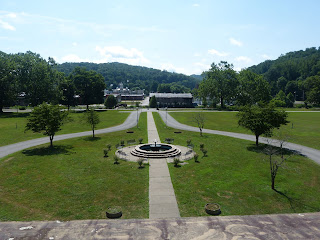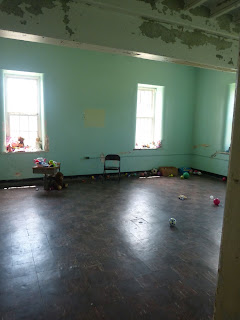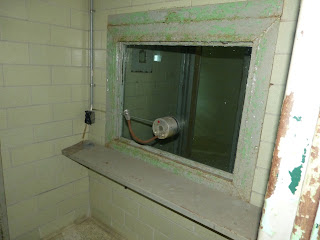We got there a bit early to get some pictures, but even from the road in front of it, it was hard to get good pictures since the main building is so sprawling. It does cut an imposing view.
We met one of the owners and she took our temperature as a coronavirus precaution. She said the previous week there was a couple who were sent away with high temperatures. There was a tented area where we could wait. Soon enough other tour goers started showing up for the Discover the Asylum tour which are the only tours they do on the day they have them and they last five hours plus lunch. Gregg and Amy where the guides as they split us into two groups. I was surprised how many near-local people where there and how many had taken previous tours - a few people many tours.
The tour started with a bit of background - notably there used to be approximately 300 similar hospitals, and the Trans-Allegheny is one of the few left largely intact.
We started with Amy as she led us through several wards. Having toured several prisons before (here, here and here), overall the asylum was a little less imposing, but still bleak and restrictive. I won't walk through the whole tour, but here are some highlights.
Nothing like Home Sweet Home.
Most of the wards looked like this.
Several areas also had large rooms. These were used for various things over the years including recreation, large housing rooms, etc.
Several areas had patient art present. The scary thing here is that I could almost see this on a wall at work...
I would occasionally break away a bit and see what else was around. This scene was almost too eerie. Which brings up one thing about the tour - it focused a bit too much on the paranormal stuff. Not that this can't be interesting, but I was hoping for a bit more history. It was only late in the day when it became evident how sketchy some of the history is with incomplete and/or inconsistent records.
Many areas of the asylum were uncomfortably jail like. But if we were to look at a Venn diagram of mental illness and prisons, there would be much overlap ... on several levels.
Another ward hallway.
How restrictive the environment was is evident through the tour.
Another ward hallway. Amy spent some time talking about the many trans-orbital lobotomies that were done at the asylum. The affects of this can be restorative, but "success" was a sliding scale and likely rare. What is unbelievably sad is that some people asked for this procedure as the living hell of mental illness could be brutal (hopefully we've progressed at least some since then).
Some of the central part of the main building is being restored. The work appears well done and much of the decor is period appropriate - if mixed - for a facility that was in use for so long.
This was part of the Doctor's quarters.
The view from the Doctor's quarters was commanding.
The asylum also had office areas. What they are hoping for eventually is a mix of unrestored and restored areas. Having walked through much of the facility, my guess is that complete restoration would probably be impossible in a lifetime.
There were several areas set up to confine patients either for their own, or others safety. Probably both.
Although this looked a little more brutal.
They also had one ward area restored. This does look almost pleasant compared to the decayed part of the asylum. It is easier to imagine how this facility really was designed to help people and the difference to a prison is more evident.
While the rooms may not be pleasant, compared to what else was available at the time (restored to look like the 1910s), it probably was.
If you listened to the Lore podcast - this is Lily's room. I wasn't sure what to make of the kid's toys (props?). Draw your own conclusions.
Walking between buildings is interesting just to look at the differences in construction with age.
We opted for the box lunch which was pretty good and a much better option than driving somewhere to eat.
Then it was time to tour some of the other buildings. We started with the Auxiliary Women's Building. From the outside it looks ok.
Once inside, I was surprised they let us in. But to be honest, I'm glad they did. Some of the opportunities for photography were too good to pass up.
This building had one of the few elevators in the facility.
But I think I'll take the stairs.
There were many, many bathrooms through the tour. Most of them have only little in the way of privacy. This has to be the worst though.
The Criminally Insane building was designed to be escape proof. And while more solid than the main building, it was apparently escaped from many times. It is definitely much more ... almost soviet bloc looking.
The door to the building was quite stuck and guide Amy had a hard time getting the door open. I helped by jiggling the key while pressing the door and got it to turn and Amy wrenched it open. I joked that nothing was going to keep me out of the Criminally Insane Building - while most residents would have said the opposite.
The building inside is in fairly good condition. The visiting area definitely looks more prison-like (with good reason).
And here we all are dutifully wearing our masks. Which does need to be talked about in this time of coronavirus. Social distancing was difficult, but I was surprised how well everyone did with masks - even the younger kids. While I may have sort of questioned the absolute safety, I never felt uncomfortable with it in its entirety.
This guy showed up. So either it was an insane deer, or the overall area has gone through a Renaissance of sorts over the years.
Then it was on to the medical building. This was the building that I did find quite creepy. I was surprised that Gregg said it was used not only for patients of the asylum, but as a hospital for others in the area. A few of us joked that we would have opted to pass on any treatment.
Yes, there was a morgue. By records, there are about 1900 people buried on the property - in reality it is probably much more.
The remnants of an old steam autoclave for surgery. In this context - it is horrifying.
We were allowed to go to the second floor of the Medical Building as well. Condition was not good, but not as bad as this picture appears. But water damage is considerable.
I was interested in how different wards had remnants of their use. Almost all the hospital rooms had these same cheap hook/shelves. I can only assume they were made on-site and possibly by patients.
As the tour wound down, we worked our way back to the tent. Thunder and lightning shook the area, bringing an almost surreal end to the tour.
I first heard about the Trans-Allegheny Lunatic Asylum about five years ago. I'm not glad the current coronavirus pandemic has killed most travel, but I am glad I've used it as a reason (or excuse) to tour the asylum. Overall, the tour was really interesting and a great photography opportunity. In hindsight, and especially with such a long history, some context around 150 years of defining and treating mental illness would have been interesting. It wasn't that it wasn't included at times, but it wasn't cohesive.
Even though the tour was a bit light on history, heavy on paranormal stuff, I probably would have been left wishing I could see more by one of the shorter tours. The Discover the Asylum tour is done with experienced guides and it showed - both Amy and Gregg were fantastic.
Putting on our motorcycle gear was not something I wanted to do, but with rain still threatening, there wasn't any choice. Thankfully, we made it back to the hotel just a few minutes before the rain really started.
Once the rain let up, dinner was take-out from Sheetz from across the street. It was ready speedy-fast and quite good.


































No comments:
Post a Comment